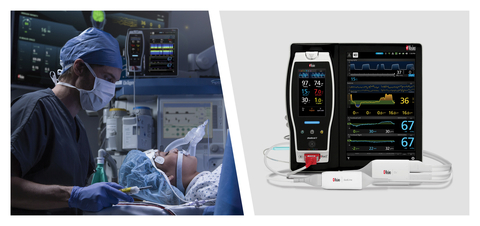NEUCHATEL, Switzerland– Masimo (NASDAQ: MASI) today announced the findings of a prospective, single-blinded, randomized controlled study published in the Journal of Anesthesia & Intensive Care Medicine in which Dr. Mona Mohamed Mogahed and colleagues at Tanta University in Tanta, Egypt and The King Fahd General Hospital in Jeddah, Saudi Arabia, sought to evaluate the impact of varying ventilation strategies on the cerebral oxygenation of patients undergoing video-assisted thoracoscopic surgery (VATS). To monitor the variety of physiological parameters needed to undertake such an evaluation, they turned to the multi-modal Masimo Root® patient monitoring and connectivity platform, which is designed to allow clinicians to streamline their ability to keep track of numerous modalities, simultaneously, using a single, intuitive monitor. The technologies involved included O3® regional oximetry, capnography with NomoLine® sampling lines, SedLine® brain function monitoring, and multiple rainbow® Pulse CO-Oximetry measurements. Using Root and Masimo monitoring technologies, the researchers were able to determine that maintaining higher end-tidal carbon dioxide (EtCO2) improved baseline regional cerebral oxygenation (rSO2), with impacts on early postoperative cognitive function that included improvements in Aldrete scores and mini mental status exam (MMSE) scores.1
Noting the increased risk of hypoxemia during one-lung ventilation (OLV) as part of VATS, which can lead to postoperative neurocognitive dysfunctions, the authors hypothesized that increasing EtCO2 could be a “convenient and powerful” way to manage cerebral desaturation during the surgery. They enrolled 70 patients, ages 18-65, undergoing elective VATS requiring OLV, between September 2021 and September 2022 at The King Fahd General Hospital, Jeddah. All patients were operated on by the same surgical team. The patients were randomly divided into two groups: in the first, EtCO2 was maintained at 32-38 mmHg (group I) and in the second, at 39-45 mmHg (group II). During the procedure, monitored parameters included oxygen saturation (Masimo SET® SpO2), heart rate (HR), and noninvasive hemoglobin (Masimo SpHb®) via an RD rainbow SET® fingertip sensor; EtCO2 via capnometer and NomoLine sampling line; noninvasive blood pressure (NIBP), body temperature, and rSO2 via O3 near-infrared spectroscopy (NIRS) sensors monitoring both brain hemispheres; and Masimo Patient State Index (PSi™), a processed EEG parameter used to help clinicians maintain appropriate sedation, via SedLine. Outcomes included Aldrete scores and MMSE scores assessed at 3 and 24 hours after surgery.
The researchers found that the percentage of change in rSO2 differed significantly between groups (p < 0.05), on both sides of the brain, with the higher values, over time, in Group II, in direct relation with the higher EtCO2 maintained in that group. In the right hemisphere, the difference became significant at the fourth time interval [T4] at which rSO2 was recorded, p = 0.0012, and maintained significance for the remainder of surgery [T4-T13], p < 0.001. In the left hemisphere, the difference became significant at T2, p = 0.09, and remained significant [T3-13], p < 0.001. Aldrete scores were significantly higher in Group II upon arrival at the post-anesthesia care unit (PACU) (p = 0.013) and 15 minutes after arrival (p = 0.03), then became comparable. MMSE scores were significantly higher in Group II 3 hours after surgery (p = 0.0009), but not at 24 hours after surgery.
The researchers concluded, “Adjusting the ventilator parameters to develop EtCO2 of 39-45 mmHg improved cerebral oxygenation more than EtCO2 of 32-38 mmHg, that play[s] a protective role in the brain, causing significant impact on the early postoperative cognitive function in patients with OLV undergoing VATS.” Regarding the use of Masimo Root and associated monitoring technologies, they noted that they “preferred using it as it can display several clinical measurements [at] the same time, such as HR, BP, temperature, SpO2, EtCO2, PSi, and rSO2.”
References
- Mogahed MM, Alnoamani TS, Elkahwagy MS. The Ventilatory Influence on Cerebral Oxygenation in Patients Undergoing Video Assisted Thoracoscopic Surgery. J Anest & Inten Care Med. 12(3). December 2022. DOI: 10.19080/JAICM.202212.555837.
- Published clinical studies on pulse oximetry and the benefits of Masimo SET® can be found on our website at http://www.masimo.com. Comparative studies include independent and objective studies which are comprised of abstracts presented at scientific meetings and peer-reviewed journal articles.
- Castillo A et al. Prevention of Retinopathy of Prematurity in Preterm Infants through Changes in Clinical Practice and SpO2 Technology. Acta Paediatr. 2011 Feb;100(2):188-92.
- de-Wahl Granelli A et al. Impact of pulse oximetry screening on the detection of duct dependent congenital heart disease: a Swedish prospective screening study in 39,821 newborns. BMJ. 2009;Jan 8;338.
- Taenzer A et al. Impact of pulse oximetry surveillance on rescue events and intensive care unit transfers: a before-and-after concurrence study. Anesthesiology. 2010:112(2):282-287.
- Taenzer A et al. Postoperative Monitoring – The Dartmouth Experience. Anesthesia Patient Safety Foundation Newsletter. Spring-Summer 2012.
- McGrath S et al. Surveillance Monitoring Management for General Care Units: Strategy, Design, and Implementation. The Joint Commission Journal on Quality and Patient Safety. 2016 Jul;42(7):293-302.
- McGrath S et al. Inpatient Respiratory Arrest Associated With Sedative and Analgesic Medications: Impact of Continuous Monitoring on Patient Mortality and Severe Morbidity. J Patient Saf. 2020 14 Mar. DOI: 10.1097/PTS.0000000000000696.
- Estimate: Masimo data on file.
- http://health.usnews.com/health-care/best-hospitals/articles/best-hospitals-honor-roll-and-overview.


